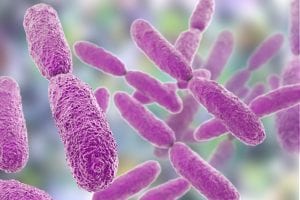The gram negative infection are a specific type of bacteria which has unique characteristics. They are classified by the color they turn after a chemical process called Gram staining is used on them. When this process is used, then the gram negative bacteria strain red while other bacteria stain blue.
They are known as gram – positive. It is known that gram – positive and gram – negative infection stain differently because their cell walls are different. It is known that they cause different types of infections and there are different types of antibiotics which are effective against them. Like most bacteria, the gram negative bacteria can cause infections throughout the body.
The most common infections caused by the gram negative bacteria are infections in the soft tissues, nervous system, bloodstream, urinary tract and lungs. Also, surgical wounds can become infected with gram negative bacteria. The gram – negative bacteria enclosed in a protective capsule. [1]

This capsule is preventing the white blood cells from ingesting the bacteria. Gram – negative bacteria have an outer membrane under the capsule which protects them against certain antibiotics, such as penicillin. When it is disrupted, this membrane is releasing toxic substances called endotoxins.
It is known that endotoxins contribute to the severity of symptoms during infections with gram – negative bacteria. The most common gram negative infection and the infections which they cause include:
- Enterobacteriaceae which is urinary tract, lung and bloodstream infections and food poisoning (includes carbapenem which is resistant Enterobacteriaceae, which are very resistant to antibiotics) [2]
- Escherichia coli (E.coli) which is food poisoning, urinary tract infections, gastroenteritis and newborn meningitis [3]
- Neisseria gonorrhoeae which is gonorrhea, a sexually transmitted disease [4]
- Pseudomonas aeruginosa which are lung and urinary tract infections
- Acinetobacter baumannii which are several types of infections in wounded soldiers [5]
- Klebsiella which is meningitis and lung, urinary tract and bloodstream infections [6]
It is noticed that the gram negative infection are increasingly becoming resistant to antibiotics. Bacteria can be resistant to because of any of the following:
- Their genes mutate.
- They are naturally resistant to certain antibiotics.
- They obtain genes from bacteria that have become resistant.
There are many gram – negative bacterial infections which happen through cross – contamination between people. There are simple measures, like healthcare workers wear gloves and gowns and washing your hands regularly, can significantly reduce the spread of bacteria. For the most healthcare – associated infections caused by gram negative bacteria there are not available vaccines.
Gram negative infection Symptoms:
The symptoms of infections caused by the gram negative bacteria depend on the location of the infection. The most common sign of infection is fever. Your doctor will ask you about your symptoms and the medical history.
He or she will make you a physical exam to determine if you have gram negative bacterial infection. Your doctor will identify the gram negative bacterial infection depending on your symptoms.
Causes:
Bacteria are normally found throughout the body and also, skin and intestines are included. When bacteria are kept in balance, then they can help the body to work normally. But the imbalance of the bacteria or passing of bacteria to areas where there are no bacteria can lead to infection.
The infection can happen if large amounts of bacteria are present, the immune system is weakened or the bacteria are aggressive. The most common ways for bacteria to pass to vulnerable parts of the body include:
- You are in a contact with someone who has or has been exposed to gram negative bacteria
- Use of medical devices that pass into the body, such as urinary catheters or IV
- Open wounds
Risk factors:
The most common risk factor for gram negative bacterial infections is the hospitalization. The longer you stay in hospital, the higher risk of infection you have. Also, there are other factors which can increase the risk of gram negative bacteria, such as
- Weakened immune system
- Recent surgery
- Mechanical ventilator use [7]
- Use of urinary catheter [8]
- A dialysis for kidney disease, which includes regular use of IV lines or catheters [9]
- War wounds
References:
[1] Negut I, Grumezescu V, Grumezescu AM. Treatment strategies for infected wounds. Molecules. 2018;23(9):2392. doi:10.3390/molecules23092392
[2] Davin-Regli A, Pages JM. Enterobacter aerogenes and Enterobacter cloacae; versatile bacterial pathogens confronting antibiotic treatment. Frontiers in Microbiology. 2015;6:392. doi:10.3389/fmicb.2015.00392
[3] Blount ZD. The unexhausted potential of E. coli. eLife. 2015;4:e05826. doi:10.7554/eLife.05826
[4] Hill SA, Masters TL,Wachter J. Gonorrhea – an evolving disease of the new millennium. Microbial Cell. 2016;3(9):371–89. doi:10.15698/mic2016.09.524
[5] Howard A, O’Donoghue M, Feeney A, Sleator RD. Acinetobacter baumannii: An emerging opportunistic pathogen. Virulence. 2012;3(3):243–50. doi:10.4161/viru.19700
[6] Podschun R, Ullmann U. Klebsiella spp. as nosocomial pathogens: Epidemiology, taxonomy, typing methods, and pathogenicity factors. Clinical Microbiology Reviews. 1998;11(4):589–603.
[7] Erfani Y, Rasti A, Janani L. Prevalence of Gram-negative bacteria in ventilator-associated pneumonia in neonatal intensive care units: a systematic review and meta-analysis protocol. BMJ Open. 2016;6(10):e012298. doi:10.1136/bmjopen-2016-012298
[8] Jacobsen SM, Stickler DJ, Mobley HLT, Shirtliff ME. Complicated catheter-associated urinary tract infections due to Escherichia coli and Proteus mirabilis. Clinical Microbiology Reviews. 2008;21(1):26–59. doi:10.1128/CMR.00019-07
[9] Murray EC, Marek A, Thomson PC, Coia JE. Gram-negative bacteraemia in haemodialysis. Nephrology Dialysis Transplantation. 2015;30(7):1202-8.




